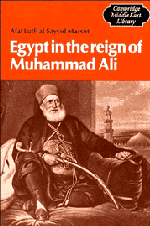Book contents
- Frontmatter
- Contents
- Dedication
- Preface
- Note on transliteration
- 1 Egypt under the mamluks
- 2 Muhammad Ali the man
- 3 A country without a master
- 4 Master in his own house
- 5 Family, friends and relations
- 6 Internal policies
- 7 Agricultural changes
- 8 Industry and commerce
- 9 Expansion to what end?
- 10 The undoing: Muhammad Ali and Palmerston
- 11 The aftermath
- 12 Conclusion
- Notes
- Glossary of Arabic and Turkish terms
- Select bibliography
- Index
9 - Expansion to what end?
Published online by Cambridge University Press: 04 April 2011
- Frontmatter
- Contents
- Dedication
- Preface
- Note on transliteration
- 1 Egypt under the mamluks
- 2 Muhammad Ali the man
- 3 A country without a master
- 4 Master in his own house
- 5 Family, friends and relations
- 6 Internal policies
- 7 Agricultural changes
- 8 Industry and commerce
- 9 Expansion to what end?
- 10 The undoing: Muhammad Ali and Palmerston
- 11 The aftermath
- 12 Conclusion
- Notes
- Glossary of Arabic and Turkish terms
- Select bibliography
- Index
Summary
Independent Egyptian rulers in the past had constantly sought to overstep the boundaries of Egypt, to occupy neighbouring countries and control trade routes that fed into Egypt. Muhammad Ali's regime, following precedent, sought to insert itself into any actual or potential vacuum in the regions surrounding Egypt and lying along her trade routes. Unlike Ottoman notables such as Jazzar, Dhahir and others who had merely sought quasi-automony for their provinces but were content to remain within the empire, Muhammad Ali sought independence. None of these provinces had the potential that Egypt possessed in terms of resources and man-power. Egypt's resources were sufficient to render the country independent, as Ali Bey had found, that is, to finance an army and a navy, to invest capital in agriculture and in industry, in brief to turn it into a state.
Had the Egyptian ruler contented himself with aspiring towards independence and a reliance on Egyptian resources alone he may not have aroused foreign antagonism. Once Muhammad Ali had acquired the trappings of a state – an army and a navy to protect his territory from invasions – and had invested capital in expanded agriculture and in starting industry, he wanted to go further. Economic expansion necessitated markets.
- Type
- Chapter
- Information
- Egypt in the Reign of Muhammad Ali , pp. 196 - 231Publisher: Cambridge University PressPrint publication year: 1984



